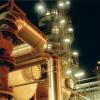Hi, I am looking into modeling the seperation of CO, Methane, and H2 (from an SMR process) with a membrane. Does anyone have advice modeling a membrane in Apsne Plus for these purposes?
|
|
Modeling Membranes In Aspen Plus
#1

Posted 30 October 2023 - 02:35 PM
#2

Posted 30 October 2023 - 08:28 PM
What do you hope to do with your simulation model? Model builders should have a goal in mind. I have seen many engineers 'build a model' and then not know what purpose it serves. Defining a purpose in the beginning will help guide how much fidelity is needed and how to know the model is complete. For modelling a membrane separation, you will need to know the separation parameters. In other words, you will have to tell the software how the components separate into product streams since it cannot determine that on its own. That would not help you design the membrane unit itself, but might be useful for sizing or rating the units connected to the membrane unit.
#3

Posted 30 October 2023 - 10:53 PM
Aspen is not able to model permeability of membrane. This parameter is subject to testing by a manufacturer.
For this purpose just use a simple split block with a manual or script adjusting of components ratio.
#4

Posted 31 October 2023 - 05:51 PM
#5

Posted 31 October 2023 - 06:15 PM
I'm hoping to model a process for the conversion of methane and water to CO and H2 and use the parameters for an optimization problem with other process. Problem for the moment is that the seperation H2, CO, and CH4 seems quite difficult to do with Aspen, I've been looking into making a custom model with ACM as I found a paper that implemented a membrane this way and was looking for advice here!
What do you hope to do with your simulation model? Model builders should have a goal in mind. I have seen many engineers 'build a model' and then not know what purpose it serves. Defining a purpose in the beginning will help guide how much fidelity is needed and how to know the model is complete. For modelling a membrane separation, you will need to know the separation parameters. In other words, you will have to tell the software how the components separate into product streams since it cannot determine that on its own. That would not help you design the membrane unit itself, but might be useful for sizing or rating the units connected to the membrane unit.
#6

Posted 31 October 2023 - 08:21 PM
Separating a stream into components in AspenPlus is easily done using the SEP unit. Specify the fraction of each component directed toward an outlet stream and the software will perform the material balance. Make sure to let the software calculate something for each component so the degrees of freedom are maintained. For example of a SEP block with two products, specify 0.99 fraction of CO sent to one stream and leave the CO specification for the other stream blank. This is a user specified forced solution and is not based on first principle thermodynamics like in a flash unit. For membrane separation the component fraction split can usually be assumed constant and the SEP unit may be good enough.
The steam-methane reformation process is one of the earliest of modern chemical engineering. It is the subject of many graduate student papers which are often found in the archives of the internet. You may find useful help in the published simulations inside those papers.
Similar Topics
Use Of Case Studt On Aspen Hysys SimulationStarted by Guest_vtf1221_* , 13 Dec 2025 |
|

|
||
Urea-Formaldehyde ModelingStarted by Guest_Lyne_* , 21 Oct 2025 |
|

|
||
Centrifugal Compressor Performance Curves In Aspen HysesStarted by Guest_Rafcio_* , 14 Mar 2024 |
|

|
||
Sigma Profile For Cosmo-Sac In Aspen PlusStarted by Guest_R.t_* , 14 Aug 2025 |
|

|
||
How To Model The Bitumen In Aspen Plus?Started by Guest_engrbab01_* , 28 Jul 2025 |
|

|

 FB
FB








